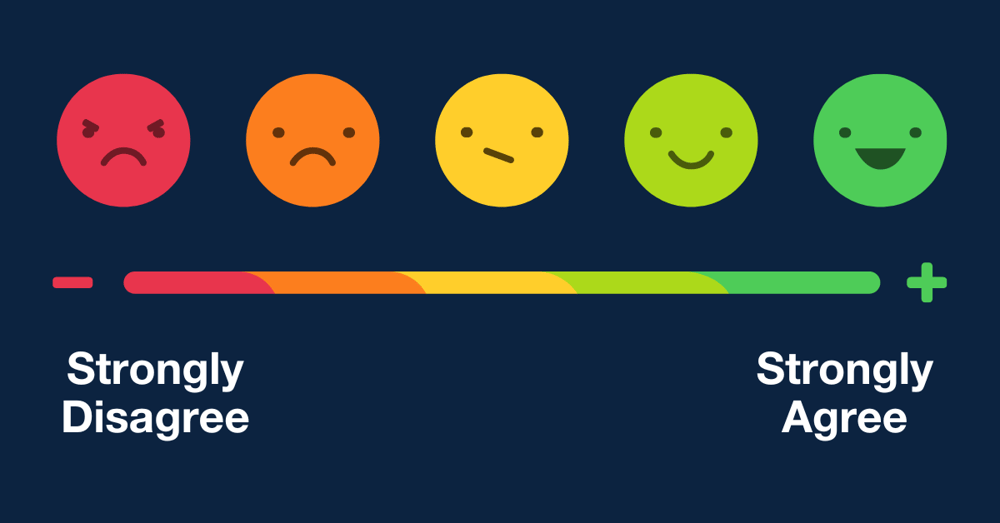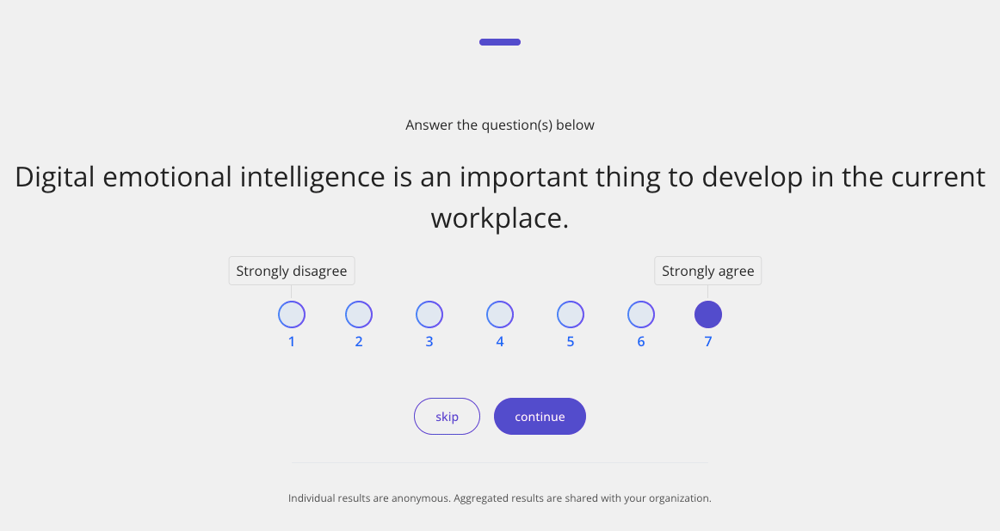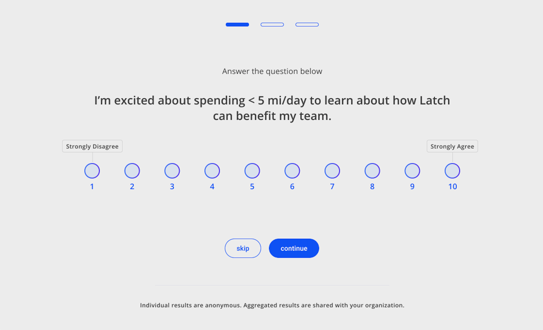
Want to know how your team really feels about what's going on in the business?
You're likely no stranger to employee engagement surveys...
The unfortunate reality is that most leaders end up disappointed or confused when survey results differ greatly from what they've heard through the grapevine.
To get to the truth, you have to consider:
- What questions should you ask?
- How should you ask those questions?
Surveys are both a science and an art form. You can kill a good question by asking it the wrong way.
Get ready to learn when, why, and how to use different survey scales to get to the heart of what you need to know from your team.
5-point Scale

A 5-point scale can be helpful when asking about something concrete or something you want to be less nebulous. This approach works best when you're trying to gauge your team's understanding of an initiative or concept.
Example: "I understand the rationale for updating our organizational strategy post-pandemic."
5-point scales are often preferred when there is a large volume of questions. Why? Because respondents can answer in this format quickly and easily – increasing the odds that they will complete the entire survey.
However, there are downsides to watch out for...
This scale is subject to response bias largely because respondents are more likely to pick the neutral response than they would with scales that have more options. Respondents may not entirely agree or entirely disagree, but with a 5-point scale, those are their only options besides a neutral stance. A vast majority of neutral responses, however, result in data that is largely useless.
Another big challenge with 5-point scales is that it's unlikely to unearth small but significant improvements over time. Subtle insights get lost because of the forced black-and-white nature of the scale. It's hard to identify obscured but critical variance.
7-point Scale

If you want to understand the intensity of a respondent's feelings or thoughts, this scale is the route you should go.
As potentially the most accurate of the Likert scales, a 7-point scale is our go-to for topics around company culture. This scale is great for questions that are more nuanced or open to interpretation and personal assessment.
Examples:
- "Our remote work policy is fair to all employees."
- "I feel valued by my employer."
- "I find purpose in my work."
Unlike the 5-point scale that captures "I get it or I don't get it" responses, a 7-point scale accommodates questions where the answers usually pack a lot more context. This scale offers more wiggle room so people feel authentic in their responses. It does so by giving a range of options that reflect moderate, extreme, intermediate, and neutral opinions.
On top of that, we have to factor in how respondents are taking the survey. Some research highlights that 7-point scales are best for electronically distributed and unsupervised surveys – which make up most, if not all, surveys in today's modern world of work.
10-point Scale

This scale works well for understanding employee or customer satisfaction and sentiment around a concrete issue or concept.
Examples:
- "How satisfied are you with the new PTO policy?"
- "On a scale of 1 to 10, how interested are you in attending a team retreat in Hawaii?"
The biggest benefit of a 10-point scale is that it eliminates the neutral point, which is generally useless from a data interpretation perspective. This makes it easy to see whether the results are positive or negative (1-5 negative and 6-10 positive). This is particularly helpful if you believe responses may trend toward the middle.
It is important to be aware that 10-point scales are likely to produce slightly lower scores than 5-point or 7-point scales. Research has explored how the 10-point format "places greater reliance on the respondent using a numerical response, for which the precise meaning has not been defined."
What's Next?
With all that high-level context in mind, let's start with what you want to know from your people.
- Is it something more tangible – like whether they would rather watch company town hall meetings live or asynchronously?
- Is it something more emotional – like whether employees feel like they can trust their leadership team?
- Do you want to measure satisfaction or interest – like whether employees are satisfied with a new policy or interested in a teambuilding activity?
For 20+ years, our SHIFT team has been helping leaders identify WHAT they want to know so we can guide HOW to best capture and measure results.
To maximize our impact, we combine the expertise of our Culture Experts with the power of our proprietary AI-powered employee engagement platform called Latch.
Our Culture Experts help leaders align the right questions with the most effective survey scale. Beyond that, Culture Experts suggest how to word survey questions in a way that minimizes bias and ensures leaders are asking what they actually want and need to know.
Utilizing AI-driven sentiment analysis and pulse survey data from Latch, our Culture Experts interpret results and call attention to variance in scores between departments or managers that may be an area you want to dive into deeper.
Thoughtful analysis of what the results mean and don't mean is critical to being able to effectively use the data to take directed action.
Ready to learn how to bring all of this to life in your organization? Email us at team@shiftthework.com.








